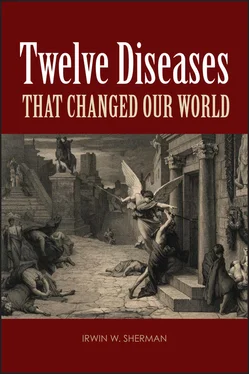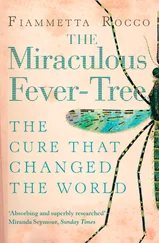Irwin W. Sherman - Twelve Diseases that Changed Our World
Здесь есть возможность читать онлайн «Irwin W. Sherman - Twelve Diseases that Changed Our World» — ознакомительный отрывок электронной книги совершенно бесплатно, а после прочтения отрывка купить полную версию. В некоторых случаях можно слушать аудио, скачать через торрент в формате fb2 и присутствует краткое содержание. Жанр: unrecognised, на английском языке. Описание произведения, (предисловие) а так же отзывы посетителей доступны на портале библиотеки ЛибКат.
- Название:Twelve Diseases that Changed Our World
- Автор:
- Жанр:
- Год:неизвестен
- ISBN:нет данных
- Рейтинг книги:5 / 5. Голосов: 1
-
Избранное:Добавить в избранное
- Отзывы:
-
Ваша оценка:
- 100
- 1
- 2
- 3
- 4
- 5
Twelve Diseases that Changed Our World: краткое содержание, описание и аннотация
Предлагаем к чтению аннотацию, описание, краткое содержание или предисловие (зависит от того, что написал сам автор книги «Twelve Diseases that Changed Our World»). Если вы не нашли необходимую информацию о книге — напишите в комментариях, мы постараемся отыскать её.
Twelve Diseases that Changed Our World — читать онлайн ознакомительный отрывок
Ниже представлен текст книги, разбитый по страницам. Система сохранения места последней прочитанной страницы, позволяет с удобством читать онлайн бесплатно книгу «Twelve Diseases that Changed Our World», без необходимости каждый раз заново искать на чём Вы остановились. Поставьте закладку, и сможете в любой момент перейти на страницу, на которой закончили чтение.
Интервал:
Закладка:
Porphyria and hemophilia illustrate how closely intertwined are disease and culture. Appreciation of this nexus can enable a better understanding of and responses to other illnesses such as the potato blight ( chapter 2), the emergence of drug-resistant tuberculosis ( chapter 7), and the pandemics of influenza ( chapter 10) and AIDS ( chapter 11). When we consider the world of the past, a time when there were no possible interventions for the “inborn errors” of porphyria and hemophilia, we can see how a disease can dramatically affect the lives of millions of people for decades. And illness, contagious or not, when present at a critical time, can affect the conduct of wars, the nature of immigration policies, the manner in which the sick are regarded by the remainder of society, and the political fortunes of nations; it can also serve to promote new strategies to protect the public health while at the same time ensuring that individual liberty is not compromised. The stories of porphyria, hemophilia, and President Kennedy's Addison's disease are tantalizing: they tempt speculation on how events in the world during the past 150 years might have turned out differently if political leaders and prominent members of royal families had not been plagued with defective genes.
2 The Irish Potato Blight
Grosse-Ile, lying in the middle of the St. Lawrence River, is a picturesque island with a background of majestic peaks. Grosse-Ile is also a place where thousands upon thousands of men, women, and children were detained and died. The Grosse-Ile station came into being when reports to the colonial government in Canada told of sick people from the Old World, especially the Irish, who were about to arrive via the St. Lawrence River. In response, the Assembly of Lower Canada (as Quebec was then called) passed a resolution on 23 February 1832 that made Grosse-Ile a detention station for sicknesses commonly believed to originate “in the homes of the human riff-raff.”
The writer Susannah Moodie, who emigrated to Canada from England in 1832, described her own impression:
“I looked up and down the glorious river; never had I beheld so many striking objects blended into one mighty whole! Nature had lavished all her noblest features in producing that enchanted scene. The rocky isle in front, with its farmhouses at the eastern point, and its high bluff at the western extremity, crowned with the telegraph . . . the middle space occupied by tents and sheds for cholera patients and its wooded shores dotted over with motley groups added to the picturesque scene . . . Never shall I forget the extraordinary spectacle that met my sight the moment we passed the low range bushes which formed a screen in front of the river. A crowd of many hundred Irish emigrants had been landed during the present and former day and all . . . men, women and children, who were not confined to the sheds (which resembled cattle pens) . . . were employed in washing clothes or spreading them out on rocks and bushes to dry. The people appeared perfectly destitute of shame or a sense of common decency. Many were almost naked, still more partially clothed. We turned in disgust from the revolting scene . . . Could we have shut out the profane sounds which came to us on every breeze, how deeply we should have enjoyed an hour amid the tranquil beauties of the . . . lovely spot.”
Although the detention of immigrants at Grosse-Ile was presumably instituted as a means of protecting the public health, in actual fact it served as a vehicle for maintaining class distinctions and scapegoating the “wretched refuse” of Ireland.
In 1833, as the number of sick immigrants arriving in Canada dwindled, the Grosse-Ile detention station fell silent. A decade later, however, it once again became active due to the changes that were taking place in Ireland. Indeed, between 1845 and 1849 the population of Ireland would decline by over 2 million. Half of these would die of starvation, disease, and malnutrition, while the other half would emigrate. The United States was traditionally the route for Irish immigrants, but in 1847 the United States enforced an increase in the cost of passage and ships that were overloaded were to be confiscated. This opened up new routes to the United States from Canada as ship owners sought a cheaper option. Hundreds of thousands of Irish were crowded aboard unsanitary sailboats unfit for transporting human beings. During the voyages of these “pest ships,” people who died, along with their possessions, were hastily wrapped in canvas and thrown overboard as if they were dead birds or garbage.
Although ships usually took 45 days to cross the Atlantic Ocean, 26 of those that set sail in 1847 took over 60 days to reach Grosse-Ile. In 1847, over 5,000 people died en route, and a like number were buried in a mass grave on the island. Four physicians at Grosse-Ile, aided by a crew of eight, worked from dawn until dark every day digging trenches and burying the dead three deep. By August, dirt had to be imported to the rocky island to bury more bodies. In spite of this, rats were coming off the ships to feed on the cadavers. All told, the number of deaths on Grosse-Ile probably exceeded 9,000, and many thousands more died elsewhere in colonial Canada during that “summer of sorrow.” The epidemic disease that prompted the Irish to leave their homeland and choose immigration and almost certain death in the passage to a foreign land was the disease known as “late blight.”
Politics and the Great Hunger
The earliest settlers in Ireland came from mainland Europe about 6000 BC, and about 400 BC the Celts from Britain and Europe arrived. In about AD 400, St. Patrick introduced Christianity to this island, along with the Roman alphabet and Latin literature. Ireland, save for fish, is without any valuable natural resources, such as gold or silver, gemstones, oil or natural gas, or iron ore, and it has an unproductive soil and miserable weather. About AD 795 the Vikings began raiding Ireland. At first the people of Ireland could do little to defend themselves, since until AD 1000 the lack of iron (as well as copper and tin) left Ireland a Stone Age economy. In 1014, the Irish King Brian Boru organized the princes of several kingdoms and drove out the Vikings. Beginning in 1160, the Normans increasingly controlled Ireland, and by 1300 they were in complete control. In 1534 Henry VIII began to try to regain Ireland from the Normans, and in 1542 he forced Ireland’s parliament to declare him King of Ireland. Henry tried to introduce Protestantism into Ireland, but without much success. Throughout the later 1500s Henry VIII’s daughter Elizabeth I strengthened the English hold and attempted to establish Protestantism. Elizabeth I outlawed Roman Catholic services and executed a number of bishops and priests. The porphyric King James I (see p. 2), who succeeded Queen Elizabeth I, continued to seize land in Ireland and give it to the English—a system known as “plantations.” This occurred especially around Ulster and established the majority of Protestants, whose descendants still live in Northern Ireland.
Under the Protestant King William III (who reigned from 1689 to 1702 and succeeded James II), Penal Laws were instituted. These laws barred Catholics from the military, commerce, and civic office; they were also denied the vote and could not purchase land. However, Catholics who converted to Protestantism were given land. In the early 1600s there were Irish revolts, but these were quickly put down by a succession of English kings; by the 1700s there was tight control by Britain. Irish Protestants objected to the restrictions, and in 1782 Britain granted autonomy to the Irish Parliament. The Catholics were given the right to hold land and to worship, but were granted no political power. In 1798, the Irish staged an unsuccessful rebellion, and although it was put down, the British Prime Minister William Pitt persuaded both the Irish and the British Parliaments to pass an Act of Union in 1801. As a result, Ireland became a part of the United Kingdom. This ended the Irish Parliament, and now Ireland would send its representatives to the British Parliament in London; later, Irish Catholics were permitted to serve in the British Parliament. During the 1800s there were several attempts to institute home rule, under which Ireland would remain a part of the United Kingdom but would have its own parliament to govern domestic affairs. The Protestants in Ulster, however, were opposed to home rule, fearing that Catholics would dominate Parliament, and so the British remained in control. In effect, Ireland became a British colony.
Читать дальшеИнтервал:
Закладка:
Похожие книги на «Twelve Diseases that Changed Our World»
Представляем Вашему вниманию похожие книги на «Twelve Diseases that Changed Our World» списком для выбора. Мы отобрали схожую по названию и смыслу литературу в надежде предоставить читателям больше вариантов отыскать новые, интересные, ещё непрочитанные произведения.
Обсуждение, отзывы о книге «Twelve Diseases that Changed Our World» и просто собственные мнения читателей. Оставьте ваши комментарии, напишите, что Вы думаете о произведении, его смысле или главных героях. Укажите что конкретно понравилось, а что нет, и почему Вы так считаете.











